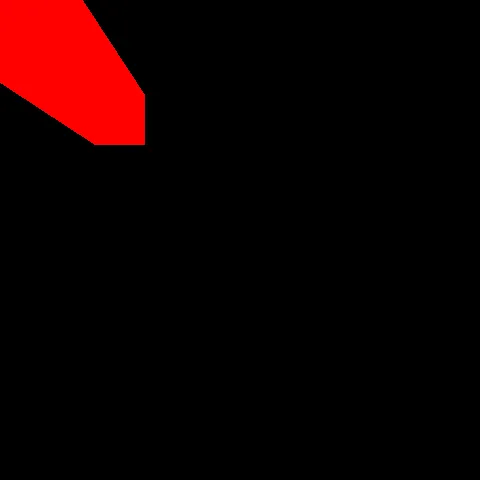我正在尝试编写一个光线跟踪器,用于任何由三角网格形成的对象。我使用外部库从.ply格式加载立方体,然后进行跟踪。到目前为止,我已经实现了大部分跟踪器,现在我正在尝试使用单个立方体进行测试,但是出现了一个问题,屏幕上只有一条红线。我已经尝试了几种方法来解决它,但是我无法再弄清楚了。对于这个主要的测试,我只创建了主要的光线,如果它们碰到我的立方体,那么我就将该像素的颜色设置为立方体的漫反射颜色并返回。为了检查光线和物体之间的交点,我遍历了形成该物体的所有三角形,并返回最近的距离。如果您能查看代码并告诉我可能出了什么问题以及出错的位置,那将非常感激。
光线-三角形相交:
光线-三角形相交:
bool intersectTri(const Vec3D& ray_origin, const Vec3D& ray_direction, const Vec3D& v0, const Vec3D& v1, const Vec3D& v2, double &t, double &u, double &v) const
{
Vec3D edge1 = v1 - v0;
Vec3D edge2 = v2 - v0;
Vec3D pvec = ray_direction.cross(edge2);
double det = edge1.dot(pvec);
if (det > - THRESHOLD && det < THRESHOLD)
return false;
double invDet = 1/det;
Vec3D tvec = ray_origin - v0;
u = tvec.dot(pvec)*invDet;
if (u < 0 || u > 1)
return false;
Vec3D qvec = tvec.cross(edge1);
v = ray_direction.dot(qvec)*invDet;
if (v < 0 || u + v > 1)
return false;
t = edge2.dot(qvec)*invDet;
if (t < 0)
return false;
return true;
}
//Object intersection
bool intersect(const Vec3D& ray_origin, const Vec3D& ray_direction, IntersectionData& idata, bool enforce_max) const
{
double tClosest;
if (enforce_max)
{
tClosest = idata.t;
}
else
{
tClosest = TMAX;
}
for (int i = 0 ; i < indices.size() ; i++)
{
const Vec3D v0 = vertices[indices[i][0]];
const Vec3D v1 = vertices[indices[i][1]];
const Vec3D v2 = vertices[indices[i][2]];
double t, u, v;
if (intersectTri(ray_origin, ray_direction, v0, v1, v2, t, u, v))
{
if (t < tClosest)
{
idata.t = t;
tClosest = t;
idata.u = u;
idata.v = v;
idata.index = i;
}
}
}
return (tClosest < TMAX && tClosest > 0) ? true : false;
}
Vec3D trace(World world, Vec3D &ray_origin, Vec3D &ray_direction)
{
Vec3D objColor = world.background_color;
IntersectionData idata;
double coeff = 1.0;
int depth = 0;
double tClosest = TMAX;
Object *hitObject = NULL;
for (unsigned int i = 0 ; i < world.objs.size() ; i++)
{
IntersectionData idata_curr;
if (world.objs[i].intersect(ray_origin, ray_direction, idata_curr, false))
{
if (idata_curr.t < tClosest && idata_curr.t > 0)
{
idata.t = idata_curr.t;
idata.u = idata_curr.u;
idata.v = idata_curr.v;
idata.index = idata_curr.index;
tClosest = idata_curr.t;
hitObject = &(world.objs[i]);
}
}
}
if (hitObject == NULL)
{
return world.background_color;
}
else
{
return hitObject->getDiffuse();
}
}
int main(int argc, char** argv)
{
parse("cube.ply");
Vec3D diffusion1(1, 0, 0);
Vec3D specular1(1, 1, 1);
Object cube1(coordinates, connected_vertices, diffusion1, specular1, 0, 0);
World wrld;
// Add objects to the world
wrld.objs.push_back(cube1);
Vec3D background(0, 0, 0);
wrld.background_color = background;
// Set light color
Vec3D light_clr(1, 1, 1);
wrld.light_colors.push_back(light_clr);
// Set light position
Vec3D light(0, 64, -10);
wrld.light_positions.push_back(light);
int width = 128;
int height = 128;
Vec3D *image = new Vec3D[width*height];
Vec3D *pixel = image;
// Trace rays
for (int y = -height/2 ; y < height/2 ; ++y)
{
for (int x = -width/2 ; x < width/2 ; ++x, ++pixel)
{
Vec3D ray_dir(x+0.5, y+0.5, -1.0);
ray_dir.normalize();
Vec3D ray_orig(0.5*width, 0.5*height, 0.0);
*pixel = trace(wrld, ray_orig, ray_dir);
}
}
savePPM("./test.ppm", image, width, height);
return 0;
}
我刚刚运行了一个测试用例,得到了这个结果:
针对一个以(0,0,-1.5)为中心,在X轴和Y轴上缩放100的单位立方体。投影似乎存在问题,但从结果中我无法确定具体是什么问题。此外,在这种情况下(立方体位于(0,0)),最终对象难道不应该出现在图片中央吗? 修复:我解决了居中问题,通过在标准化和调用跟踪函数之前做ray_dir = ray_dir - ray_orig。 但是,透视似乎完全错误。
